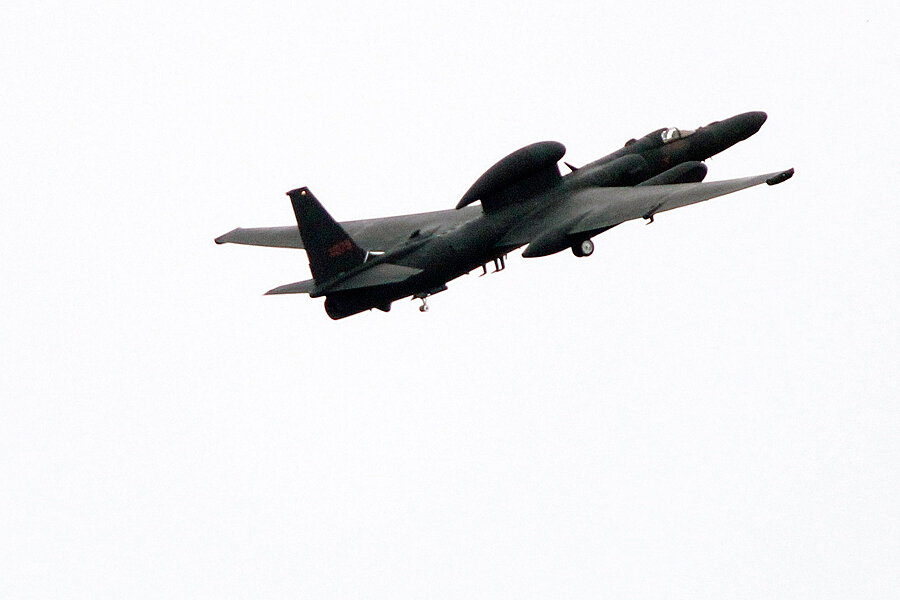New defense budget: Will it ground famous U-2 spy plane?
Loading...
Is the Dragon Lady going to be grounded for good? That’s the implication of President Obama’s fiscal year 2015 military budget, outlined Monday by Secretary of Defense Chuck Hagel. Among the many trims it contains is the elimination of funds for the U-2 “Dragon Lady” spy plane. The famed aircraft would be retired – finally – in favor of the long-range Global Hawk drone.
We say “finally” because budgeters have been trying to get rid of the U-2 for years. But the plane has proved its versatility and importance again and again in real-world conflicts. In Afghanistan, U-2s with upgraded sensors could spot soil disturbances that hinted at the placement of roadside bombs. More recently, in Syria, U-2s tracked the regime's chemical weapon-related activity.
It’s possible the U-2 will yet avoid the budget ax. The plane flies higher than the Global Hawk, an important advantage in overhead espionage, and carries a wider array of sensing equipment. For these and other reasons, the Air Force leadership would prefer the manned aircraft over the drone.
But the Global Hawk can stay aloft for a day and is much younger. There isn’t enough money in the budget for both, according to the Pentagon, so one must go. So let’s pause for a second to recognize the greatness of the U-2, a design that has lasted half a century and is “one of the most famous and successful aircraft of all time,” in the words of aviation historian Walter J. Boyne.
The U-2 program dates from 1955. The US needed a spy aircraft that could fly to the edge of space, higher than the Soviet Union's interceptors, to try to discover the many military secrets in the vast interior of the USSR. It was a joint CIA-Defense Department program. In fact, a senior CIA official sent a $1.25 million check to the home of Lockheed “Skunk Works” chief engineer Kelly Johnson to get the program under way in secret.
In the end, the US got 20 aircraft delivered under budget at about $1 million each. In essence, the U-2 is a jet-powered glider, with long, thin wings unable to withstand the strain of combat maneuvers. It can fly higher than 70,000 feet, and it can carry a wide array of electronic and imaging sensors in under-wing pods.
It’s notoriously difficult to fly, in part because it pushes the edge on performance. At altitude, pilots have to keep speed within a window of about 12 miles per hour. Too fast, and structural damage may result. Too slow, and the plane might fall into a potentially fatal stall.
On landings (and takeoffs) the U-2 is followed by high-performance chase cars containing pilots who call out key information such as angle and altitude. It has only a bicycle landing gear, to save weight, so as it comes to a halt one wing will dip and scrape along the tarmac. Protective wing tips guard against damage.
It became famous in 1960, when Gary Francis Powers was shot down in a U-2 while overflying Soviet missile sites. In 1962, photos taken from the U-2 revealed Soviet missiles in Cuba, sparking the Cuban missile crisis. In the early 1960s, U-2s operating from India overflew China. In 1964 a U-2 was launched from an aircraft carrier in Operation Fish Hawk to provide clandestine reconnaissance of the French nuclear test site in the Pacific.
Since then, it has overflown pretty much every area of armed conflict in which the US has been engaged. The airframe’s adaptability is long proven – even today its payload is about 67 percent larger than that of the Global Hawk.
Air Force leaders may like it today, but that wasn’t always so. The legendary Gen. Curtis LeMay, chief of Strategic Air Command, opposed it due its lack of weaponry or standard landing gear. Its “U” designation stands for “Utility” – a deception at the time, but apt now as it appears headed for retirement.








